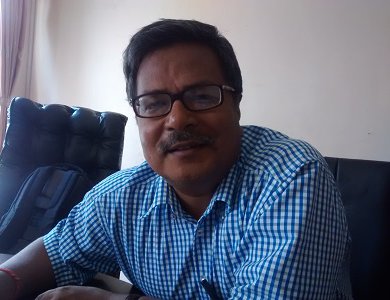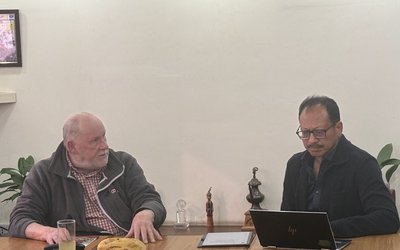
What lessons have we learned from the condition of the nation’s priority project following the earthquakes of April and May?
Nepal needs to broaden its scope and area of study on seismic vulnerabilities. Previously, we were calculating the possible damage of great earthquakes like that of 1934, focusing our projections in Kathmandu. However, the last earthquakes have taught us that we need to prepare for seismic vulnerabilities and damage nationwide. Before April 25, whenever one talked about an earthquake damage, the great earthquake of 1934 was taken as an example. The April 25 earthquake and subsequent aftershocks have shown that it is not enough.
At a time when many hydropower projects are under construction in many seismically vulnerable areas, as a project chief of Nepal’s largest hydropower project with a national priority, what do you say?
Just parroting the lessons of 1934 earthquake and focusing in Kathmandu alone would not be enough. The situation has changed a lot in the last eight decades. There are many hydropower projects, road projects and other infrastructures close to epicenters and seismically vulnerable areas. So far as hydropower plants are concerned, mountains and Himalayan foothills are considered as good sites because rocks are strong and good in these areas. Thus, these areas have now turned into hub for hydropower. Before April 25 earthquake, no one had made an exact calculation on how earthquakes would damage these projects. Nepal lies in a seismically active zone, particularly the Himalayas and hills, we need to seriously study seismic vulnerabilities of the region before taking the projects.
What about the Upper Tamakoshi project?
Our project has not suffered much and the insurance will cover certain parts of the damage that occurred during the earthquake. The damage is manageable.
How do you describe the level of damage?
There is a very nominal damage in the underground structures. The earthquake has had high effects on the surface structures. Since Tamakoshi is dominated by underground structures, the earthquake has made nominal destruction on permanent structures. However, the quake has affected the dam sites. Since dam is a surface structure, the earthquake has damaged it a little. The road has also been damaged by the earthquake badly. Our camp area has also been destroyed. Although much of our structures remain intact, the destruction of access road has delayed resumption of the work.
At a time when Nepal has been seeking foreign investment in the areas of hydropower, learning from Upper Tamakoshi, can we say that that the underground structures are safe in seismic zones?
We cannot generalize this. Construction of hydropower projects depends on the project site and demand and supply sides. There is the need to build surface infrastructure in some projects and underground structures in others. The project depends on several factors. We need to apply preventive measures for all projects, including the mega projects. Even in the designing phase, we always avoid fault lines. So far as underground or surface infrastructures are concerned, this is more of a technical or engineering judgment.
How do you describe the damage in the Upper Tamakoshi project?
The first earthquake of April 25 did some damage. When we were in the process of collecting the damage data, the May aftershocks badly hurt the efforts. The epicenter of a major May earthquake was close to our project site, even a big mountain fell near our project. Aftershocks increased the damage. They damaged the access roads, particularly in Singati. We are facing difficulties to reopen the road to dam site at Lamabagar.
As Upper Tamakoshi was making progress, meeting its target before earthquake, what will be the likely impacts of earthquake on it? How long will be its delay?
We are still in the process of study. As monsoon is likely to be there till the end of September, we cannot say anything exactly now. However, what I can say is that the project will be delayed for at least a year from the proposed deadline.
Will it also increase the cost?
It will depend on the situation. The damage by earthquake will be recovered from insurance. The insurance will cover ninety percent of the damage incurred in the infrastructure. However, we cannot recover the generating loss. For instance, the loss of generation revenue in one year will be much higher. There will also be extra cost for further strengthening the infrastructure. We are even considering redesigning our control room from surface to underground. It will increase the cost a little. However, we cannot recover the loss of revenue. Cost of capital will increase, including the interest rate. We have yet to look at the escalation in cost.
What is the state of construction of transmission lines?
The construction of transmission lines has already started. We have already mobilized the team in scattered areas. The main problem is road rehabilitation. We will resume our work from September 18 or bishowkarma puja.
What is the exact state of the road?
The road is badly damaged. Only light vehicles are heading from Singati to Gonger. The road from Gonger to dam site needs to be rehabilitated completely. Since stones are still falling, we cannot start the work now.
Will it still be the cheapest project even after the damage by the earthquakes?
We can say this only after how much damage the project has incurred and other factors like delay in work. Cost of capital will determine the value of cost. It will have definite impacts on the project, but one cannot say right now how much. The time overrun will affect the revenue.
It is said that the dam is in deposited soil. Some experts argue that the project built a big dam ignoring their technical suggestions. How do you look at this?
The dam has already a settlement of 18 centimeter in accumulative calculation after the earthquake. Recently, we have invited a panel of experts form USA. They have made some recommendations. They have drawn the conclusion that the dam is out of danger and suggested we take certain precautionary measures. Mitigation measure is needed. There is no loss in tunnel but there is a lot of waste inside the dam. In total, there is no major damage in structures, it will take two to three months to release water accumulated in the tunnel.
Given Nepal’s geography and seismological vulnerabilities, how safe is building big reservoir projects in Nepal?
Hydropower site selection is linked to the economy. The selection of storage and run of the river projects depends on the demand side. We don’t have other sources than the hydro. Every project involves risks and there is no safe project. What is important is diverse location of projects in terms of region and place.
- MELAMCHI WATER SUPPLY: No Interruption During Monsoon
- Jun 25, 2025
- KOREAN RETURNEES: Successful Integration
- Jun 25, 2025
- UPPER TRISHULI-1: Engaging With Local
- Jun 25, 2025
- IME GROUP: Twenty Five Years Of Journey
- Jun 24, 2025
- NEPAL’S AIR POLLUTION: A Growing Health Concern
- Jun 24, 2025















